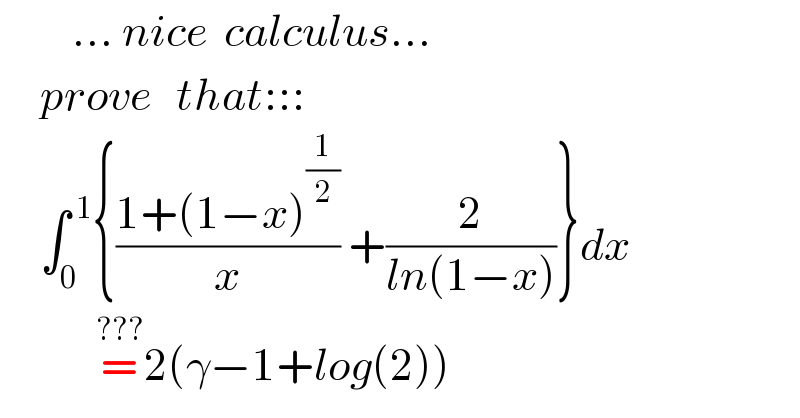
Question and Answers Forum
Question Number 124064 by mnjuly1970 last updated on 30/Nov/20

Answered by mindispower last updated on 01/Dec/20
![let ln(1−x)=−t ⇔∫_0 ^∞ {((1+e^(−(t/2)) )/(1−e^(−t) ))−(2/t)}e^(−t) dt =∫_0 ^∞ −((2e^(−t) )/t)+((1+e^(−(t/2)) )/(1−e^(−t) ))e^(−t) dt =−2∫{(e^(−t) /t)−(1/2)((1+e^(−(t/2)) )/(1−e^(−t) ))e^(−t) }dt =−2∫(e^(−t) /t)−(e^(−3(t/(2 ))) /(1−e^(−t) ))+(1/2).((e^(−(t/2)) −1)/(1−e^(−t) )).e^(−t) dt =−2∫_0 ^∞ {(e^(−t) /t)−(e^(−3(t/2)) /(1−e^(−t) ))}dt+∫_0 ^∞ ((1−e^(−(t/2)) )/(1−e^(−t) ))e^(−t) dt Ψ(z)=∫_0 ^∞ ((e^(−t) /t)−(e^(−zt) /(1−e^(−t) )))dt we get −2Ψ((3/2))+∫_0 ^∞ ((e^(−t) dt)/(1+e^(−(t/2)) ))=−2Ψ((3/2))+A A=∫_0 ^∞ {e^(−(t/2)) −1+(1/(1+e^(−(t/2)) ))}dt A=lim_(x→∞) ∫_0 ^x {e^(−(t/2)) −1+(1/(1+e^(−(t/2)) ))}dt =lim_(x→∞) [−2e^(−(x/2)) +2−x+2ln(e^(x/2) +1)−2ln(2)] =lim_(x→∞) [2−x+2.(x/2)+2ln(1+e^(−(x/2)) )−2ln(2)] =2−2ln(2) Ψ((3/2))=Ψ((1/2))+2=−2ln(2)−γ+2 we get −2(−2ln(2)−γ)+2−2ln(2) =2ln(2)+2γ−2=2(−1+γ+ln(2)) ∫((1+(√(1−x)))/x)+(2/(ln(1−x)))dx=2(γ−1+ln(2))](Q124159.png)
Commented by mnjuly1970 last updated on 01/Dec/20

Commented by mindispower last updated on 02/Dec/20

Answered by mnjuly1970 last updated on 01/Dec/20
![solution we know that .. i: ∫_0 ^( 1) ((1/(ln(x)))+(1/(1−x)))dx=_([IMAGE⇓⇓]) ^(why?) γ ✓ ii:∫_0 ^( 1) ((t^n −1)/(ln(t)))dt=^(why?) ln(n+1) ✓ Φ=∫_0 ^( 1) (((1+(√(1−x)))/x)+(2/(ln(1−x))))dx =^(1−x=t^2 ) 2∫_0 ^( 1) {((1+t)/(1−t^2 ))+(2/(2ln(t)))}tdt =2∫_0 ^( 1) ((1/(1−t))+(1/(ln(t))))tdt =2∫_0 ^( 1) (((t−1+1)/(1−t))+((t+1−1)/(ln(t))))dt =2∫_0 ^( 1) ((1/(1−t))+(1/(ln(t))))dt−2+∫_0 ^( 1) ((t^1 −1)/(ln(t)))dt =2γ−2+ln(2)=2(γ−1+ln(2))✓](Q124166.png)
Commented by mnjuly1970 last updated on 01/Dec/20

Commented by mnjuly1970 last updated on 01/Dec/20

